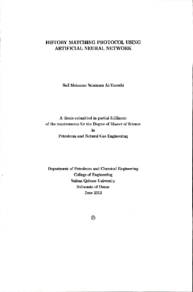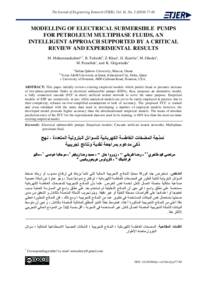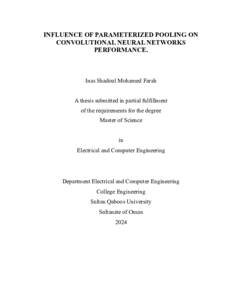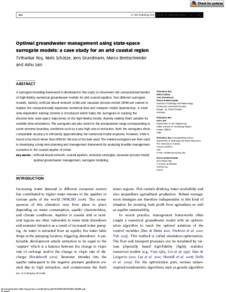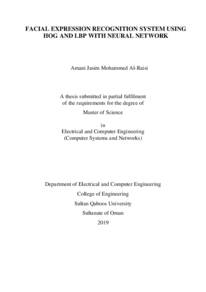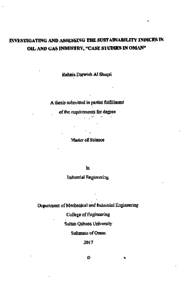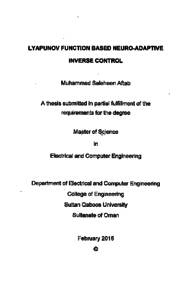Document
History matching protocol using artificial neural network
Publisher
Sultan Qaboos University
Gregorian
2013
Language
English
English abstract
Modelling complex hydrocarbon reservoir systems is a challenging process that in volves history matching of actual production and pressure data and subsequently forecasting reservoir behaviour. History matching is done through systematic mod ifications of the numerical reservoir models in order to re-produce actual produc tion rates and pressure profiles.
The most common conventional approach in history matching is the tedious and time consuming 'trial and error' which involves manual, in some cases random and inconsistent, modifications to the parameters of the reservoir model until the simulated results match with acceptable accuracy the actual reported production and pressure data. To ensure uniqueness of the history matched reservoir model, numerical optimization and geological consistency must be observed in the modi fication process.
Automated history matching methods were introduced to overcome the manual history matching drawbacks. Automated methods are faster techniques for his tory matching compared to manual method. Larger number of parameters can be dealt with as well. However, in large and complex models, the automated tech niques suffer from some challenges. The major challenges are: the inflexibility to incorporate into existing simulators, large number of runs required and con vergence issues for multidimensional problems. To overcome some of these issues, new techniques like Artificial Neural Network (ANN) and Ensemble Kalamn Filter (EnKF) were introduced.
In this work, a history match protocol involving artificial neural network (ANN) is developed to predict accurate reservoir model parameters. The protocol con sists of four main stages: selection of target parameters and ranges, simulation to obtain ANN inputs (pressure and/or production), ANN training and validation, and finally prediction of reservoir parameters for history match. The protocol was tested with a real gas reservoir with limited production data. The target parame ters tested were: porosity and permeability multipliers, formation compressibility, and Corey exponents for water and gas.
Several network configurations and components were tested to investigate their effect on ANN performance. The prediction error was different for each of the tar get parameters. The highest prediction error was associated with compressibility values and vertical permeability multipliers. Whereas, Corey exponents prediction error was the lowest compared to the other parameters.
The final optimized ANN was used to predict the simulation parameters for better history match in a dry gas carbonate reservoir. The resulting history match is excellent and showed that ANN is a robust tool for history match.
Member of
Resource URL
Arabic abstract
إن نمذجة الأنظمة المعقدة للمكامن الهيدروكربونية تمثل عملية تحدي تشتمل على معايرة النموذج مع كل من سجل الإنتاجية والضغط الحقيقيين لمعرفة السلوك المستقبلي للمكمن الهيدروكربوني. تتم عملية المعايرة من خلال تغيير معطيات النماذج الحسابية للخزان للوصول إلى نتائج مقاربة للمعدلات الحقيقية للضغط والإنتاج. هذه المقاربة في المعدلات بين النماذج الحسابية والمعدلات الحقيقية تكون ضمن نسبة خطأ ضئيلة مقبولة. الطريقة الشائعة في المعايرة هي الطريقة التقليدية المشتملة على التجربة والخطأ وهي عبارة عن عدة محاولات عشوائية ضمن حدود معينة في محاكات المكامن عن طريق تغيير العوامل حتى الوصول إلى نتائج تكون قريبة من الوضع الحقيقي للمكامن، ولضمان جودة المعايرة لا بد من مراقبة أداء وتحسين النموذج الحسابي بحيث يكون أقرب للنتائج الحقيقية للخزان و ومتطابقة مع الخصائص الجيولوجية بجانب الطريقة التقليدية في المعايرة، هناك طرق أوتوماتيكية للحصول على نتائج مقبولة بشكل أسرع مع التعامل مع عدد أكبر من العوامل. بالرغم من هذه الميزات لا تزال هذه الطرق تعاني من عدة مشكلات مثل: الحاجة الى عدد كبير من محاولات المعايرة أو إنحراف النمذجة الحسابية عن الحل بسبب الإختلاف الكبير في إتجاهات العوامل. للتغلب على بعض هذه المشكلات تم إستخدام ما يعرف بشبكة العصب الصناعي (ANN) للتنبؤ بالعوامل الصحيحة لنموذج المكمن وهذه الآلية تتكون من أربع مراحل رئيسية وهي: إختيار العوامل المؤثرة وحدودها رجات ANN)، المحاكاة للوصول إلى نتائج الضغط أو الإنتاجية أو كليهما بإستخدام العوامل السابقة للحصول على المدخلات، تدريب وتمرين الشبكة العصبية (ANN) بإستخدام المدخلات والمخرجات، فحص مدى ملائمة إستجابة الشبكة لمدخلات عوامل جديدة من الضغط والإنتاج لم تعرض من قبل خلال فترة التدريب وبعد الرضاء عن الأداء تستخدم الشبكة للتنبؤ بالعوامل المناسبة لمعايرة المكمن.
هذه الطريقة تم إختبارها في معايرة نموذج مكمن غاز حقيقي مع محدودية المعلومات المتوفرة عن إنتاجية الماء المصاحب للغاز وضغط المكمن.
العوامل التي إختبارها هي مضاعفات المسامية والنفاذية وعامل الإنكماش للتكوين بالإضافة إلى ما يعرف بعاملي الأس الكوري للماء والغاز. هناك عدة تشكيلات للشبكات ومكوناتها تم تطويرها لإختبار وفحص تأثيرها على أداء الشبكة وعند مقارنة نسبة الخطأ في التنبؤات للعوامل إختلفت النتائج مع إختلاف العوامل المستهدفة (المخرجات)، في قيم الإنكماش ومضاعفات النفاذية الرأسية كانت عالية نسبيا في حين كان عاملي الأس الكوري (Cory Exponent) للماء والغاز الأقل خطأ في التنبؤات مقارنة بنتائج العوامل الأخرى. نتائج المخرجات النهائية للعوامل والتي تنبأت بها الشبكة العصبية الصناعية (ANN) أستخدمت لمحاكات مكمن الغاز الهيدروكربوني الجاف. ولقد كانت نتائج المعايرة ممتازة جدا وأثبتت أن طريقة (ANN) من الأدوات السليمة والقوية لمعايرة نماذج المكامن الهيدروكربونية.
هذه الطريقة تم إختبارها في معايرة نموذج مكمن غاز حقيقي مع محدودية المعلومات المتوفرة عن إنتاجية الماء المصاحب للغاز وضغط المكمن.
العوامل التي إختبارها هي مضاعفات المسامية والنفاذية وعامل الإنكماش للتكوين بالإضافة إلى ما يعرف بعاملي الأس الكوري للماء والغاز. هناك عدة تشكيلات للشبكات ومكوناتها تم تطويرها لإختبار وفحص تأثيرها على أداء الشبكة وعند مقارنة نسبة الخطأ في التنبؤات للعوامل إختلفت النتائج مع إختلاف العوامل المستهدفة (المخرجات)، في قيم الإنكماش ومضاعفات النفاذية الرأسية كانت عالية نسبيا في حين كان عاملي الأس الكوري (Cory Exponent) للماء والغاز الأقل خطأ في التنبؤات مقارنة بنتائج العوامل الأخرى. نتائج المخرجات النهائية للعوامل والتي تنبأت بها الشبكة العصبية الصناعية (ANN) أستخدمت لمحاكات مكمن الغاز الهيدروكربوني الجاف. ولقد كانت نتائج المعايرة ممتازة جدا وأثبتت أن طريقة (ANN) من الأدوات السليمة والقوية لمعايرة نماذج المكامن الهيدروكربونية.
Category
Theses and Dissertations

